
Launch Complex 38 (originally "Army Launch Area Five") [1] was the White Sands Missile Range facility for testing the Nike Zeus anti-ballistic missile. The site is located east of the WSMR Post Area.

Launch Complex 38 (originally "Army Launch Area Five") [1] was the White Sands Missile Range facility for testing the Nike Zeus anti-ballistic missile. The site is located east of the WSMR Post Area.
In February 1957, the prototype Nike Hercules installation was completed at White Sands Launch Complex 37, and a satisfactory flight test was conducted on March 13 (92 Hercules firings through November 13, 1957 [2] --Operation Understanding civilian tours were conducted in 1967.) [3] The 1956 [4] Nike II anti-ballistic missile study for an advance Project Nike evolved into the development program for the Nike Zeus ABM [5] and in January 1961, "ARGMA submitted the “NIKE-ZEUS Defense Production Plan” to the Chief of Ordnance". [6] Ascension Island's Target Tracking Radar was checked out on January 16, 1961, [4] and used to create recordings of radar reception from Cape Canaveral warheads, "chunks of the booster rocket", and "nose cone decoys" during reentry for use as simulated "ghost" missile input during WSMR's Zeus "synthetic intercept" program." [7]
Deployment of the Zeus Acquisition Radar (ZAR) at the planned Launch Complex began in October 1958 [8] near an airstrip. [9] The LC-18's rectangular compound for the ZAR buildings at 32°24′28.5″N106°15′25.0″W / 32.407917°N 106.256944°W [10] was begun between AMTC and Oro Grande. [9] The ZAR power building housed "nine 1,500kW generators", [4] and ZAR initial operation was in June [11] /July 1961. [6] The HAPDAR (HArd Point Demonstration Array Radar) [12] construction began 16 July 1965 in the former ZAR Receiver building. [13]

The Nike Zeus prototype launching facilities in the design by the Burns and Roe Company [4] was begun in 1959 [14] and completed in October 1962. [15] LC-18 had a Battery Control Building ("contained two Missile Track Radars, the Target Intercept Computer, and data communication equipment"), [11] a Launch Control Building (LCB, now used for the Patriot missile), Launch Cell, [16] tunnel, [17] and nearby tracking radar. [18] WSMR also had Zeus storage bunkers with sloped ends. [19] The first launch from the LC-38 "R & D underground emplacement" was on April 28, 1960, [4] and the last WSMR Zeus launch was the 72nd "firing" in December 1963 [20] after 18 failures. [11]
| External image | |
|---|---|
The Zeus "Discrimination Radar (DR) and Target Tracking Radar (TTR) were used as part of a re-entry signature studies program" [21] --"the first successful Athena test missile fired from Utah into WSMR" was in June 1964. [11] White Sands was also the site of the AMRAD—ARPA Measurements Radar [22] —built 1961-3 for assessing reentry of the Special Test Vehicle of Athena/ABRES firings. [23] In 1965, seven [24] HIBEX missiles were tested at WSMR, [25] and the first Sprint missile launch was at WSMR in November 1965. [26]
Bell Telephone Laboratories [27] started the Multi-function Array Radar (MAR-I) construction at WSMR for Nike-X in March 1963. [28] MAR-1 was based on the ZAR, and was the basis for the Kwajalein Missile Site Radar. [2] in September 1968. In February 1974 the last "operational NIKE-ZEUS facility, Target Track Radar-4, ceased operations" [29] and during the War on Terror, the tunnel complex was used for simulating a Taliban combat area.
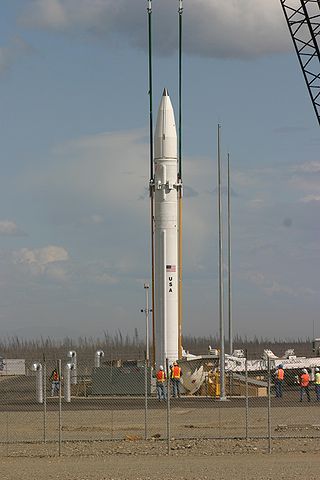
An anti-ballistic missile (ABM) is a surface-to-air missile designed to counter ballistic missiles. Ballistic missiles are used to deliver nuclear, chemical, biological, or conventional warheads in a ballistic flight trajectory. The term "anti-ballistic missile" is a generic term conveying a system designed to intercept and destroy any type of ballistic threat; however, it is commonly used for systems specifically designed to counter intercontinental ballistic missiles (ICBMs).
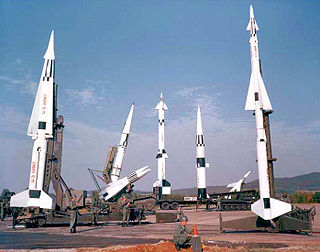
Project Nike was a U.S. Army project, proposed in May 1945 by Bell Laboratories, to develop a line-of-sight anti-aircraft missile system. The project delivered the United States' first operational anti-aircraft missile system, the Nike Ajax, in 1953. A great number of the technologies and rocket systems used for developing the Nike Ajax were re-used for a number of functions, many of which were given the "Nike" name . The missile's first-stage solid rocket booster became the basis for many types of rocket including the Nike Hercules missile and NASA's Nike Smoke rocket, used for upper-atmosphere research.

White Sands Missile Range (WSMR) is a United States Army military testing area and firing range located in the US state of New Mexico. The range was originally established in 1941 as the Alamogordo Bombing and Gunnery Range, where the Trinity test site lay at the northern end of the Range, in Socorro County near the towns of Carrizozo and San Antonio. It then became the White Sands Proving Ground on 9 July 1945.
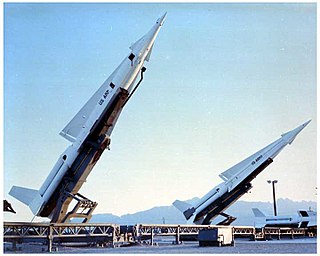
The Nike Hercules, initially designated SAM-A-25 and later MIM-14, was a surface-to-air missile (SAM) used by U.S. and NATO armed forces for medium- and high-altitude long-range air defense. It was normally armed with the W31 nuclear warhead, but could also be fitted with a conventional warhead for export use. Its warhead also allowed it to be used in a secondary surface-to-surface role, and the system also demonstrated its ability to hit other short-range missiles in flight.

Missile defense is a system, weapon, or technology involved in the detection, tracking, interception, and also the destruction of attacking missiles. Conceived as a defense against nuclear-armed intercontinental ballistic missiles (ICBMs), its application has broadened to include shorter-ranged non-nuclear tactical and theater missiles.

The Safeguard Program was a U.S. Army anti-ballistic missile (ABM) system designed to protect the U.S. Air Force's Minuteman ICBM silos from attack, thus preserving the US's nuclear deterrent fleet. It was intended primarily to protect against the very small Chinese ICBM fleet, limited Soviet attacks and various other limited-launch scenarios. A full-scale attack by the Soviets would easily overwhelm it. It was designed to allow gradual upgrades to provide similar lightweight coverage over the entire United States over time.
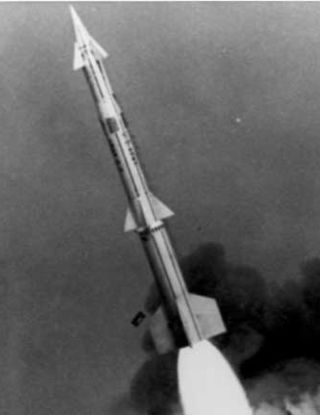
The LIM-49 Spartan was a United States Army anti-ballistic missile, designed to intercept attacking nuclear warheads from Intercontinental ballistic missiles at long range and while still outside the atmosphere. For actual deployment, a five-megaton thermonuclear warhead was planned to destroy the incoming ICBM warheads. It was part of the Safeguard Program.
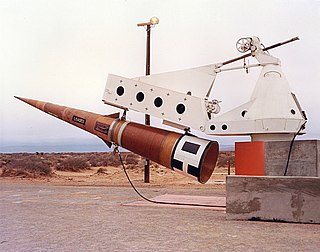
The Sprint was a two-stage, solid-fuel anti-ballistic missile (ABM), armed with a W66 enhanced-radiation thermonuclear warhead used by the United States Army during 1975–76. It was designed to intercept incoming reentry vehicles (RV) after they had descended below an altitude of about 60 kilometres (37 mi), where the thickening air stripped away any decoys or radar reflectors and exposed the RV to observation by radar. As the RV would be traveling at about 5 miles per second, Sprint needed to have phenomenal performance to achieve an interception in the few seconds before the RV reached its target.

The A-350 GRAU 5V61 was a Soviet, nuclear armed surface-to-air anti-ballistic missile. The A-350 was a component of the A-35 anti-ballistic missile system. Its primary mission was to destroy U.S. Minuteman and Titan intercontinental ballistic missiles targeting Moscow.

The Type 03 Medium-Range Surface-to-Air Missile or SAM-4 or Chu-SAM is a Japanese developed surface-to-air missile system currently in service with the JGSDF. The SAM's vehicle chassis is based on the Kato Works Ltd/Mitsubishi Heavy Industries NK series heavy crane truck. It uses a state-of-the-art active electronically scanned array radar.

The Western Electric System 1393 Radar Course Directing Central (RCDC) was a Cold War complex of radar/computer systems within the overall Improved Nike Hercules Air Defense Guided Missile System. The RCDC was installed at the "battery control areas" of ~5 hectares each which was for commanding a nearby missile Launching Area (LA), firing a missile from the LA, and guiding a launched missile to a burst point near an enemy aircraft.
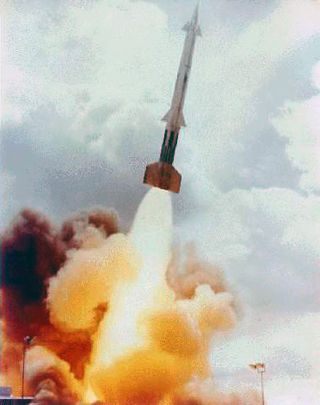
Nike Zeus was an anti-ballistic missile (ABM) system developed by the US Army during the late 1950s and early 1960s that was designed to destroy incoming Soviet intercontinental ballistic missile warheads before they could hit their targets. It was designed by Bell Labs' Nike team, and was initially based on the earlier Nike Hercules anti-aircraft missile. The original, Zeus A, was designed to intercept warheads in the upper atmosphere, mounting a 25 kiloton W31 nuclear warhead. During development, the concept changed to protect a much larger area and intercept the warheads at higher altitudes. This required the missile to be greatly enlarged into the totally new design, Zeus B, given the tri-service identifier XLIM-49, mounting a 400 kiloton W50 warhead. In several successful tests, the B model proved itself able to intercept warheads, and even satellites.

The Nike Ajax was an American guided surface-to-air missile (SAM) developed by Bell Labs for the United States Army. The world's first operational guided surface-to-air missile, the Nike Ajax was designed to attack conventional bomber aircraft flying at high subsonic speeds and altitudes above 50,000 feet (15 km). Nike entered service in 1954 and was initially deployed within the United States to defend against potential Soviet bomber attacks, though it was later deployed overseas to protect US military bases, and was also sold to various allied militaries. Some examples remained in use until the 1970s.
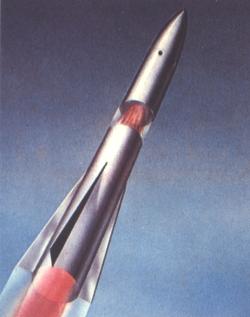
Project Wizard was a Cold War-era anti-ballistic missile system to defend against short and medium-range threats of the V-2 rocket type. It was contracted by the US Army Air Force in March 1946 with the University of Michigan's Aeronautical Research Center (MARC). A similar effort, Project Thumper, started at General Electric.
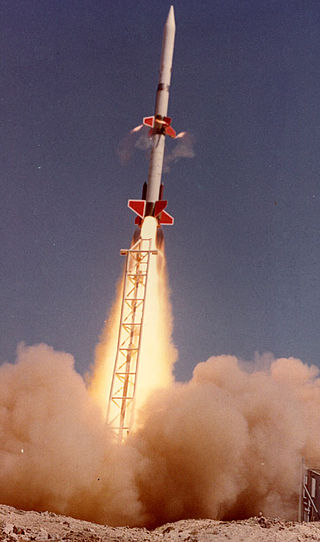
The Utah Launch Complex was a Cold War military subinstallation of White Sands Missile Range for USAF and US Army rocket launches. In addition to firing Pershing missiles, the complex launched Athena RTV missiles with subscale (test) warheads of the Advanced Ballistic Re-entry System to reentry speeds and impact at the New Mexico range. From 1964 to 1975 there were 244 Green River launches, including 141 Athena launches and 60 Pershing 1 and Pershing 1a launches to 281 kilometers altitude. "Utah State Route 19 runs through the Green River Launch Complex, which is south of the town and eponym of Green River."

The AN/FPQ-16 Perimeter Acquisition Radar Attack Characterization System is a powerful United States Space Force phased-array radar system located in North Dakota. It is the second most powerful phased array radar system in the US Space Force's fleet of missile warning and space surveillance systems, behind the more modern PAVE PAWS phased array radar.

Nike-X was an anti-ballistic missile (ABM) system designed in the 1960s by the United States Army to protect major cities in the United States from attacks by the Soviet Union's intercontinental ballistic missile (ICBM) fleet during the Cold War. The X in the name referred to its experimental basis and was supposed to be replaced by a more appropriate name when the system was put into production. This never came to pass; in 1967 the Nike-X program was canceled and replaced by a much lighter defense system known as Sentinel.

Sentinel was a proposed US Army anti-ballistic missile (ABM) system designed to provide a light layer of protection over the entire United States, able to defend against small ICBM strikes like those expected from China, or accidental launches from the USSR or other states. The system would have seventeen bases, each centered on its Missile Site Radar (MSR) and a computerized command center buried below it. The system was supported by a string of five long-range Perimeter Acquisition Radars (PAR) spread across the US/Canada border area and another in Alaska. The primary weapon was the long-range Spartan missile, with short range Sprint missiles providing additional protection near US ICBM fields and PAR sites. The system would initially have a total of 480 Spartan and 192 Sprint missiles.
In air and missile defense (AMD), the Integrated Air-and-Missile Defense system (IAMD) is an SMDC research program to augment the aging surface-to-air missile defense systems and to provide the United States Army with a low-cost, but effective complement to kinetic energy solutions to take out air threats. Brigade level higher energy lasers are used in truck mounted systems called HELMTT. At lower levels, the Army needs to develop interceptors that don't cost more than small, unmanned aircraft systems. In early research they have successfully used 5-kilowatt lasers on a Stryker combat vehicle. The Mobile Expeditionary High-Energy Laser (MEHEL) was used at MFIX at Fort Sill, Oklahoma, in the first half of April, 2017.
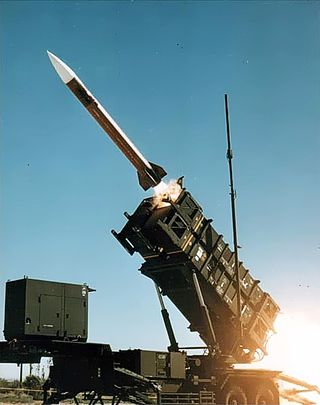
The United States Army Integrated Air and Missile Defense [IAMD] Battle Command System (IBCS) is a plug and fight network intended to let any defensive sensor feed its data to any available weapon system. The system is designed to shoot down short, medium, and intermediate range ballistic missiles in their terminal phase by intercepting with a hit-to-kill approach. IBCS has been developed since 2004, with the aim to replace Raytheon's Patriot missile (SAM) engagement control station (ECS), along with seven other forms of ABM defense command systems. In 2022, IBCS successfully completed initial operational test and evaluation (IOT&E), and was approved for full-rate production in 2023.
During 1956, the Army asked Bell Telephone Laboratories to investigate the feasibility of producing a system which could provide defence against an ICBM. ... During 1957 the Army authorized the long-established Nike team to start the design of the Nike Zeus system... Nike Zeus early test configuration ]... Prime industrial contractor [for Nike Zeus] is the Western Electric Co. ... 1955 Whippany Initial studies by Bell Telephone Laboratories.] ...
Launch Complex 38...Site preparation for the TTR [Target Tracking Radar] began in July 1959. ... Site preparation for the Discrimination Radar was started in January 1961.
the ZAR represents the most efficient wired-logic system for detection, report sorting, track initiation, and track processing ever developed. Its stacked-array receivers on three rotating arms also provided the highest data rate (measured for full hemispheric coverage) yet achieved, and is not matched even by today's phased-array systems. ... Principal features of the NIKE-X System concept were summarized in a paper, "NIKE-X, Design Approach and Preliminary Description" which was presented at the Anti-Missile Research and Advisory Council (AMRAC) Symposium, April 15, 1963, in Monterey, California. ... TTR No. 4 was changed from a 22- to a 40-foot antenna dish and a wideband 60-MHz coherent system. (See Figure 1-35.) In addition, an X-band receiver system was added to provide telemetry reception from NIKE-X supported RVs equipped with special on-board instrumentation.
[Nov 1968] The HAPDAR (HArd Point Demonstration Array Radar) described is a multifunction phased array radar in operation at the White Sands Missile Range. The principle design feature is the TACOL (Thinned Aperture COmputed Lens) array.
This is the housing for a giant radar antenna for the Nike Zeus anti-missile missile. [Sign at minute 17:50:] Systems Test Division Blockhouse Area